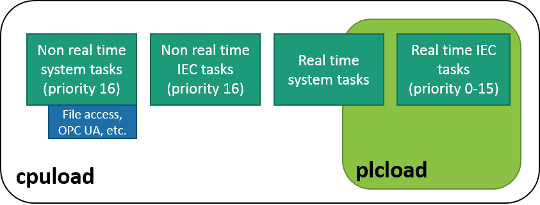The parameters cpuload and plcload represent the actual CPU load or PLC load of the system.
-
cpuload: This value represents the time the PLC requires to calculate all processes running on the PLC. For a good system performance this value should be less than 80%. In case of a higher value, the degree of utilization should be reduced by using a more powerful PLC or by reducing the amount of processes. -
plcload: This value represents the time the PLC requires to calculate all real-time processes. Real-time processes are either high priority system tasks or IEC tasks with a priority between 0 and 15. For a good system performance this value should be less than 60%. In case of a higher value, the degree of utilization should be reduced by using a more powerful PLC.
During commissioning we recommend to monitor the CPU and PLC values online with one of the following methods:
Automation Builder
-
Commissioning via 'PLC shell commands'⮫ “PLC shell commands” (command 'plcload' and 'cpuload').
-
Commissioning via 'Application at runtime'. In order to display the load of the CPU or PLC, create a new Device Trace object in your PLC project. Then upload the data into the views 'Command 'Upload Trace'.
IEC applications/IEC program
To access the parameters plcload and cpuload please use system functions as follows:
-
plcload: SchedGetProcessorLoad() included in library ‘CmpSchedule’. -
cpuload: SysMCGetLoad() included in library ‘SysCpuMultiCore’.

